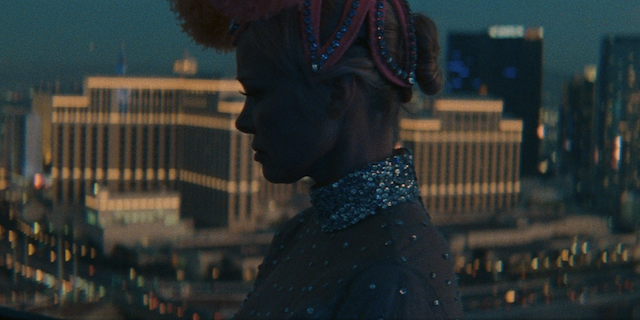
Las Vegas, showgirls and Pamela Anderson. One can easily imagine this film to be filled with sparkle, glitter, neon signs and energetic dancing, perhaps a sibling film to Paul Verhoeven‘s “Showgirls” (1995). But Gia Coppola‘s “Palo Alto” (2013), latest film is everything but. This is a dreamy and intimate character study of a veteran Las Vegas dancer reeling from the news that her career has hit its expiration date. Pamela Anderson has the role of her career, and a deep spray tanned Jamie Lee Curtis reshapes the meaning of Bonnie Tyler’s “Total Eclipse of the Heart”.
The film opens with Shelley (Pamela Anderson) , a 57-year-old woman auditioning for a dance job wearing feathers and tons of makeup on stage. The camera is close to her face. She is attractive, the eyes are desperate. Nervously she stumbles over her words. We then see her off-stage, bare faced and ordinary, looking like any neighbor in the stairway. This is a woman who has been dancing on a Las Vegas stage as a showgirl for over 30 years.
It is literally her life, her family are the young women she shares the stage with. Naturally, she is devastated when the stage manager announces her long-running show, Razzle Dazzle, will close permanently in two weeks. Dancing is the only job skill she has. It’s her identity and has been a safe space for decades – she gave up the rest of her life, even a marriage and a daughter, for it. Being 50 something and getting a job in this harsh business is a challenge, to say the least.
Pamela Anderson is genuinely cut and ready for the role. She seems to embody every inch of experience the character goes through with emotional honesty. After the world premiere- screening at TIFF, she declared she’d been waiting for the role her whole life. Typecast as a sex symbol, being “Baywatch” poster girl, Anderson’s real life parallels her character getting pushed out of the industry due to her age. There are certain similarities to Darren Aronofsky’s “Wrestler” (2008), a film which also revolved around, and followed intimately, a middle-aged star who has seen the glory days. Mickey Rourke gave a career-redefining performance and got him an Oscar nomination. This one could be Anderson’s ignition.
Here she is vulnerable and multilayered yet determined. Her almost baby-doll voice could be a reminder that she once was being defined by her good looks. Equally extraordinary are the other actors. Jamie Lee Curtis shows her range and nails it in a supporting role as Shelley’s friend Annette. For her the stage life as a showgirl is long gone, now she’s hanging on as a cocktail waitress at the same club. She is loud and tough with a brassy wig and gambling problems. She balances the roughness with comedic timing. When she dances on a table to Bonnie Tyler’s “Total Eclipse of the Heart”, your own heart stops for a moment.
Anderson’s Shelley is treated with respect by her fellow stage dancers Jodie (Kiernan Shipka) and Marianne (Brenda Song), two very young, bright and already experienced girls who won’t have problems finding new jobs. The only masculine presence is represented by the stage manager and Shelley’s former boyfriend Eddie (Dave Bautista who is quietly forceful).
Gia Coppola puts the women in the front seat. This homage to sisterhood and female fellowship examines ageist bullying and depicts the lost American dream in a gently touching way. Shelley gave up everything for the stage, for being seen and validated. Now she must confront it all. Not only as a dancer but also as a mother. Her estranged daughter, played nuanced by Billie Lourd, shows up and, almost against her will, sees her mother on stage. “A stupid nudie show”, she calls it. The mother-daughter reunions are both confrontational and endearing.
Francis Ford’s granddaughter and Sofia’s niece, Gia Coppola, proves to have undoubtedly talent showing a personal distinctive style with a subtle eye for storytelling and tone. Many of her family members were involved – her cousin Jason Schwartzman has a small role, and his brother Robert stands as producer. The screenwriter Kate Gersten is married to another cousin and Jaqui Getty, Coppola’s mother, is a costume designer. Gia Coppola contemplates and observes her characters and builds the whole film around Pamela Anderson. It’s a very good choice. With strikingly soft cinematography by Autumn Durald Arkapaw, she captures the state of mind of a broken person and her surroundings in dim lighting and behind the curtain mood. A peek into the unforgiving neon city of sin.
B+
If you like the review, share your thoughts below!

